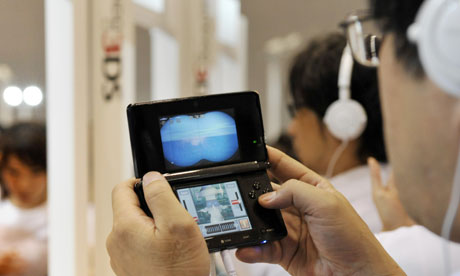
Until now, those who wanted to watch 3D pictures required a cheap set of plastic glasses and an expensive cinema ticket or Sky subscription. But Nintendo's new games console – the handheld 3DS - is the first mainstream device to boast "glasses-free" stereoscopic effects.
Launched throughout Europe at midnight on Thursday, the 3DS allows players to perceive the extra dimension in a similar way to movies such as Toy Story 3 and Avatar.
The console's screen uses technology known as a parallax barrier, which overlays an LCD display with a series of precise slits providing a slightly different version of the image to each eye. While the Japanese electronics manufacturer Sharp has already used these displays in laptops, this is the first time the technology has been made available to a global audience.
But the invention has not been without controversy. Since the console was announced last summer, there have been concerns about the effects of the 3D visuals on users' eyes, and Nintendo has advised that children under six do not play games with the 3D functionality switched on (a slider control on the side of the screen allows gamers to choose the intensity of the 3D effect, or turn it off altogether).
The British Association of Optometrists has suggested that the proximity of the device to the face could cause eye stress in young children, as their vision is still developing.
Such concerns, however, have not dampened enthusiasm. At last month's Japanese launch, the device was a sell-out, with 400,000 units shifting in the first 24 hours. Nintendo says it expects to sell 4m consoles worldwide before the end of March. British retailers are already offering discounts from the RRP of £229, with Tesco selling units at £175.
The 3DS represents the latest move for a company that had been written off as a force in games hardware until the unexpected success of the motion-sensing Wii games console. "Nintendo 3DS … continues the tradition Nintendo has for changing the technology landscape," said Laurent Fischer, Nintendo of Europe's Managing Director of Marketing.
This is not Nintendo's first foray into 3D gaming. In 1995, the company launched the Virtual Boy, a bizarre "virtual reality" device resembling an old Viewmaster toy, which featured basic monochromatic visuals created via red LED pixels. The device was withdrawn a year later.
This time, judging by the excitement of gamers gathering outside HMV's Oxford Street branch, some of whom had been there for over 24 hours, it is unlikely that the 3DS will suffer such an ignoble fate.
A new "StreetPass" mode allows the console to detect when other 3DS owners are nearby, prompting the two devices to automatically swap game items, characters and scores as they pass.
Nintendo has also announced partnerships with Eurosport and Sky to bring 3D video clips to the 3DS, though pricing details have not yet been revealed. Movie studios such as DreamWorks, Disney and Warner are also set to release their latest 3D titles on the platform.

